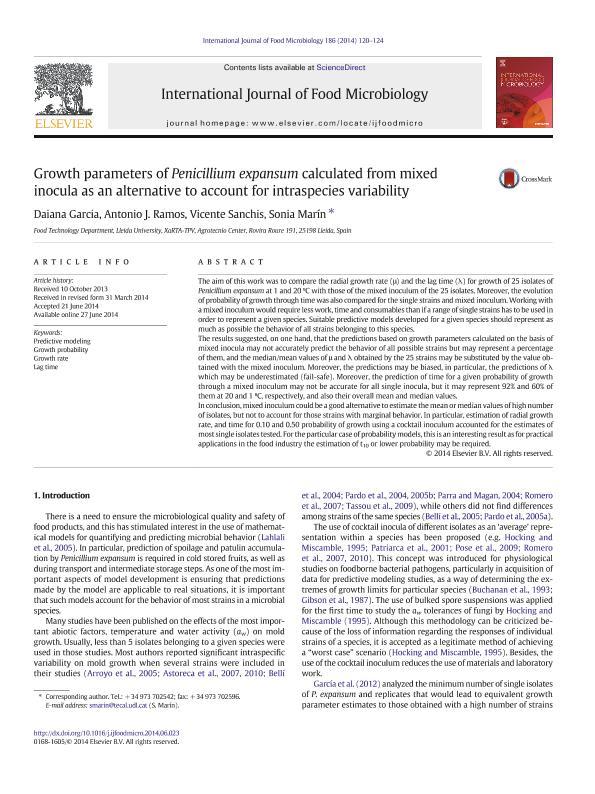Mostrar el registro sencillo del ítem
dc.contributor.author
García, Daiana

dc.contributor.author
Ramos, Antonio J.
dc.contributor.author
Sanchis, Vicente
dc.contributor.author
Marín, Sonia
dc.date.available
2018-01-22T14:53:30Z
dc.date.issued
2014-06
dc.identifier.citation
García, Daiana; Ramos, Antonio J.; Sanchis, Vicente; Marín, Sonia; Growth parameters of Penicillium expansum calculated from mixed inocula as an alternative to account for intraspecies variability; Elsevier Science; International Journal of Food Microbiology; 186; 6-2014; 120-124
dc.identifier.issn
0168-1605
dc.identifier.uri
http://hdl.handle.net/11336/34068
dc.description.abstract
The aim of this work was to compare the radial growth rate (μ) and the lag time (λ) for growth of 25 isolates of Penicillium expansum at 1 and 20 ºC with those of the mixed inoculum of the 25 isolates. Moreover, the evolution of probability of growth through time was also compared for the single strains and mixed inoculum. Working with a mixed inoculum would require less work, time and consumables than if a range of single strains has to be used in order to represent a given species. Suitable predictive models developed for a given species should represent as much as possible the behavior of all strains belonging to this species. The results suggested, on one hand, that the predictions based on growth parameters calculated on the basis of mixed inocula may not accurately predict the behavior of all possible strains but may represent a percentage of them, and the median/mean values of μ and λ obtained by the 25 strains may be substituted by the value obtained with the mixed inoculum. Moreover, the predictions may be biased, in particular, the predictions of λ which may be underestimated (fail-safe). Moreover, the prediction of time for a given probability of growth through a mixed inoculum may not be accurate for all single inocula, but it may represent 92% and 60% of them at 20 and 1 ºC, respectively, and also their overall mean and median values. In conclusion, mixed inoculum could be a good alternative to estimate the mean or median values of high number of isolates, but not to account for those strains with marginal behavior. In particular, estimation of radial growth rate, and time for 0.10 and 0.50 probability of growth using a cocktail inoculum accounted for the estimates of most single isolates tested. For the particular case of probability models, this is an interesting result as for practical applications in the food industry the estimation of t10 or lower probability may be required.
dc.format
application/pdf
dc.language.iso
eng
dc.publisher
Elsevier Science

dc.rights
info:eu-repo/semantics/openAccess
dc.rights.uri
https://creativecommons.org/licenses/by-nc-sa/2.5/ar/
dc.subject
Predictive Modeling
dc.subject
Growth Probability
dc.subject
Growth Rate
dc.subject
Lag Time
dc.subject.classification
Otras Ciencias Biológicas

dc.subject.classification
Ciencias Biológicas

dc.subject.classification
CIENCIAS NATURALES Y EXACTAS

dc.title
Growth parameters of Penicillium expansum calculated from mixed inocula as an alternative to account for intraspecies variability
dc.type
info:eu-repo/semantics/article
dc.type
info:ar-repo/semantics/artículo
dc.type
info:eu-repo/semantics/publishedVersion
dc.date.updated
2018-01-22T14:16:24Z
dc.journal.volume
186
dc.journal.pagination
120-124
dc.journal.pais
Países Bajos

dc.journal.ciudad
Amsterdam
dc.description.fil
Fil: García, Daiana. Consejo Nacional de Investigaciones Científicas y Técnicas; Argentina. Universidad de Lleida; España
dc.description.fil
Fil: Ramos, Antonio J.. Universidad de Lleida; España
dc.description.fil
Fil: Sanchis, Vicente. Universidad de Lleida; España
dc.description.fil
Fil: Marín, Sonia. Universidad de Lleida; España
dc.journal.title
International Journal of Food Microbiology

dc.relation.alternativeid
info:eu-repo/semantics/altIdentifier/doi/http://dx.doi.org/10.1016/j.ijfoodmicro.2014.06.023
dc.relation.alternativeid
info:eu-repo/semantics/altIdentifier/url/http://www.sciencedirect.com/science/article/pii/S0168160514003092
Archivos asociados
